INTERACTIVE POWERPOINTS DEVELOPMENT AS LEARNING MEDIA IN IMPROVING COMMUNICATION SKILL FOR SECOND SEMESTER OF ENGLISH DEPARTMENT STUDENTS AT ABA BALIKPAPAN
A Descriptive Research
Abstract
This study aims to describe the development stage learning media in the form of interactive multimedia powerpoints, describe the quality of the learning media developed in the form interactive multimedia powerpoint and describe lecturer and student’s responses on the use of learning media in the form of interactive multimedia power point. This research is the second semester of second semester of English students of ABA Balikpapan. Determination sample using random sampling technique. Based on these techniques, obtained 1 class of 4th students as test subjects. Data collection technique using a questionnaire in the form of a questionnaire that must be filled in by lecturers and students after using the learning media. Before being tested, the media learning through the media validation stage and material validation by media experts and material expert. The data analysis technique used descriptive qualitative, with transforming qualitative data into quantitative data. The result of this research is an interactive media of communication learning powerpoint which is packaged on a class presentation. Stages in development These media are (1) Initial data collection, (2) Product development, (3) Validation of material experts and media experts, (4) Revision, (5) Product testing, (6) Analysis data and (7) Revision of the final product. The results of this study consist of two aspects, namely the quality of the media and responses users. In the aspect of media quality, the assessment is carried out by media experts and experts Theory. In the aspect of user responses, the assessment is carried out by lecturer and students. Assessment by media experts got a percentage of 63%. Expert assessment material gets a percentage of 90%. Assessment by subject lecturers get a percentage of 83%. Assessment by students gets a percentage amounted to 65.5%. The overall average rating was 75%. Result This research proves that this powerpoints learning media is feasible to use based on validation tests by material experts and media experts.
References
Abdullah, A., Yaacob, M.R., Ismail, M.B., Abdullah, Z., Mohd Radyi, S.A. (2017). Corporate engagement with the community: Building relationships through CSR. Journal of Engineering and Applied Sciences, 12(2): 1538-1538.
Adler, R. B., Rosenfeld, L. B., & Proctor, R. F. (2014), Interplay: The process of interpersonal communication. New York: Oxford University.
Auer, P. (2014). Theories and methods. The Hague, The Netherlands: Mouton De. Patterson, P. G., & Spreng, R. A. Modeling the relationship between perceived value, satisfaction and repurchase intentions in a business-to-business, services context: An empirical examination. International Journal of Service Industry Management, 8(5), 414-434.
Asiamah, N., Mensah, H. K., & Oteng-Abayie, E. F. (2017). General, target, accessible population: Demystifying the concepts for effective sampling. The Qualitative Report, 22(6), 1607-1622. Retrieved 3rd November 2018 from http://nsuworks.nova.edu/tqr/vol22/iss6/9.
Aziz, Y.A., Samdin, Z., Awang, K.W., Abdullah, Z. (2015). Developing an Index for Medical Tourism. International Business Management, 9(4), 412-415.
Bandura, A. Social cognitive theory. In W. Donsbach (Ed.). (2008). The international encyclopedia of communication [electronic version]. London, England: Blackwell. Retrieved 1st October 2018 from www.tandfonline.com
Baškarada, S. (2014). Qualitative case study guidelines. The Qualitative Report, 19(40), 1-18. Retrieved 4th November 2018 from http://nsuworks.nova.edu/tqr/vol19/iss40/3
Carr, K., Holman, A., Stephenson-Abetz, J., Koenig Kellas, J., & Vagnoni, E. (2015). Giving voice to the silence of family estrangement: Comparing reasons of estranged parents and adult children in a non-matched sample. Journal of Family Communication, 15, 130-140.
Cornelissen, J. (2014). Corporate communication: A guide to theory and practice. London: Sage.
Ekpe, I., Razak, R. C., Ismail, M., & Abdullah, Z. (2015). Entrepreneurial skill acquisition and youth’s self-employment in Malaysia: How far? Mediterranean Journal of Social Sciences, 6(4), 150–154.
Fang, Y. H., Tang, K., Li, C. Y., & Wu, C. C. (2018). On electronic word-of-mouth diffusion in social networks: Curiosity and influence. International Journal of Advertising, 37, 360-384.
Fang, Y. H. A (2019). dual process model of help-seeking on social media websites. Journal of Communication Research, 31, 48-52.
Fussell, S. R. & Kreuz, R. J. (2014). Social and cognitive approaches to interpersonal communication: Introduction and overview. Psychology Press. Mahwah, NJ: Lawrence Erlbaum Associates.

Journey: Journal of English Language and Pedagogy by http://ejurnal.budiutomomalang.ac.id/index.php/journey/index is licensed under a Creative Commons Attribution-ShareAlike 4.0 International License.






